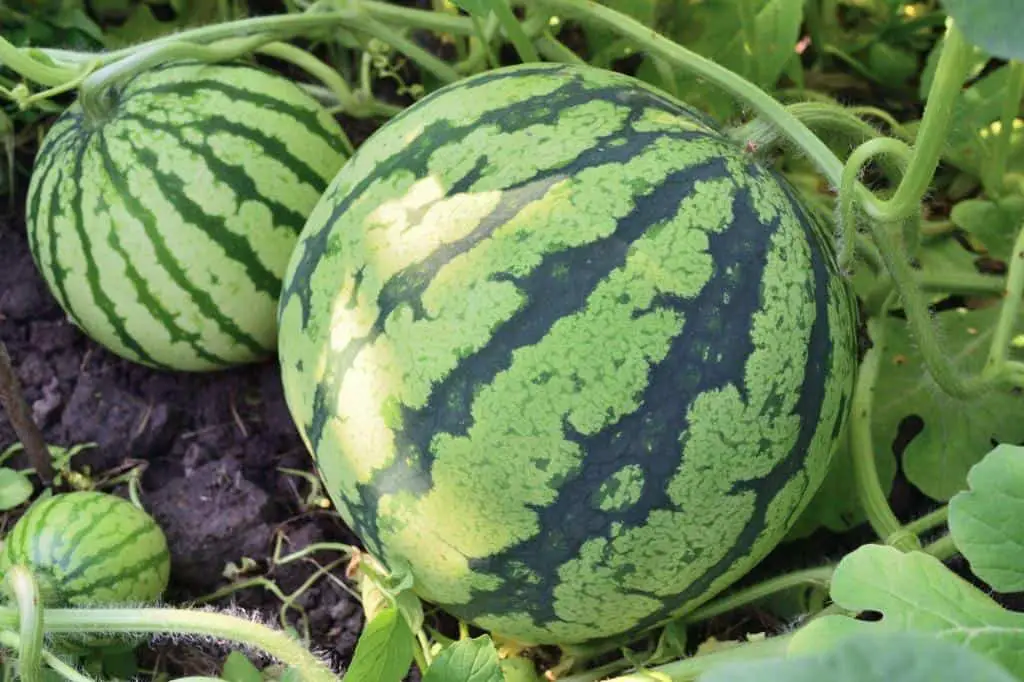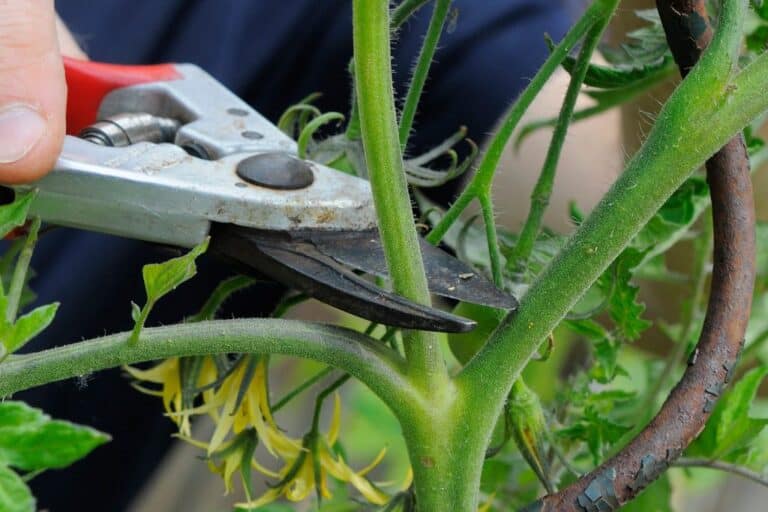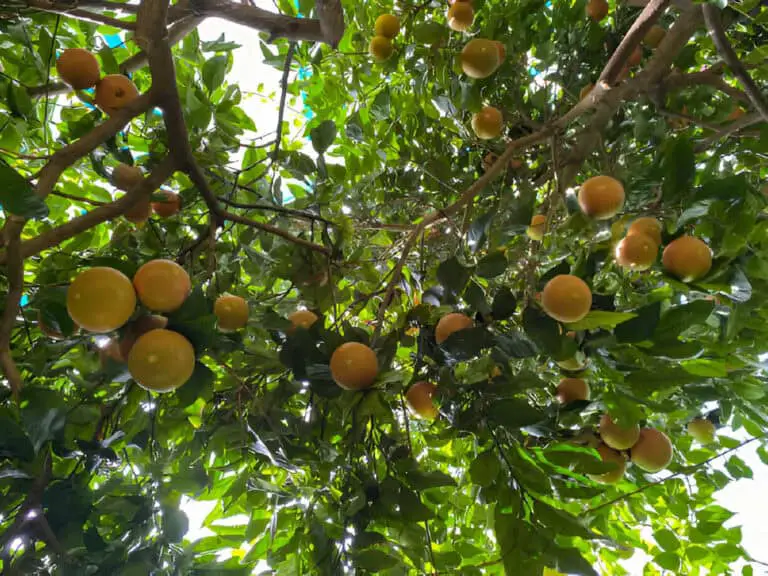How Much Do Watermelons Weigh? – Average, Low, and High

Watermelons, the quintessential summer fruit, have a knack for stealing the show at picnics and barbecues. Their vibrant colors and juicy sweetness make them a crowd favorite. But have you ever wondered about the weight of these giant green orbs? We’re diving deep into the world of watermelons to answer the burning question: How much do they really weigh?
‘How Much Do Watermelons Weigh?—Average, Low, and High’ delves into the often-overlooked world of these luscious fruits, uncovering the intricate balance between nature’s hand and human cultivation.
Out of the 39 watermelon varieties grown, the lightest average weight was Lemon Ice at 13 lbs, and the heaviest was ORS6260 at 21.2 lbs. The average weight of the 39 different varieties grown was 17.2 lbs.
From backyard garden gems to record-breaking behemoths, the weight of watermelons varies more than you might think. In this exploration, we’ll take you on a journey through the averages, the surprisingly lightweight specimens, and the jaw-dropping heavyweights that can give even the mightiest pumpkin a run for its money.
Whether you’re a curious kitchen connoisseur, a gardener eager to grow your own, or just someone who enjoys a refreshing slice on a hot summer’s day, understanding the weight of watermelons will add a new layer of appreciation for this beloved fruit. So, grab a slice, settle in, and prepare to be amazed by the world of watermelon weights!
Watermelon Categories by Weight
Watermelons are separated into three main categories by weight: personal (mini) watermelons, icebox watermelons, and picnic watermelons. Other ways watermelons are divided are seeded or seedless, yellow or green exteriors, and yellow, orange, and white fleshed watermelons.
How Much Does a Personal Watermelon Weigh?
Personal watermelons weigh about 5 lbs. and range from 3-7 lbs. These are the smallest watermelons and are also called mini-watermelons.
Pony Red Mini and Yellow Baby are two popular varieties of personal watermelons.
How Much Does an Icebox Watermelon Weigh?
Icebox watermelons were originally grown to produce a watermelon that fit into a refrigerator more easily than a picnic watermelon. They range from 6-15 lbs.
Sugar Baby, Tiger Baby, and Gold in Gold are three popular icebox watermelon varieties.
How Much Does a Picnic Watermelon Weigh?
The watermelon image that comes to most of our minds when we hear the word is a picnic watermelon. Picnic watermelons weigh on average 17 lbs. or 7,711 grams.
In a grow trial in North Carolina 39 different picnic varieties of watermelon were grown to test how different varieties performed in local conditions.
A picnic watermelon is the biggest of the watermelons and averages around 17 lbs. with a common range of 15-25 lbs.
It is not uncommon to get larger watermelons in the garden where watermelon plants have more space than commercial grows. More space equals more light, water, and nutrients for the plant to produce bug fruit.
The largest watermelon on record was 351 lbs. This watermelon was of the variety “Carolina Cross’ ‘ and was grown in Tennesse in 2013.
Picnic watermelons offer the most varieties available to choose from. A few popular picnic watermelon varieties are Jubilee, Crimson Sweet, and Buttercup.
Variations in Watermelon Weight
As you can see the weight of a watermelon can range from 1 lb. to over 300 lbs. In the garden watermelon plants have more space and will produce more watermelons on an individual plant. Even the size of the watermelons from the same plant will vary.
As you explore the world of watermelons, you’ll realize that there’s no one-size-fits-all answer when it comes to their weight. Different types of watermelons can have significantly different weights. Here’s a brief overview of the variations you might encounter:
| Watermelon Variety | Average Weight |
| Seedless Watermelon | 10-20 pounds |
| Seeded Watermelon | 15-25 pounds |
| Mini Watermelon | 5-10 pounds |
| Personal Watermelon | 5-7 pounds |
| Large Watermelon | 25-35 pounds and more |
Keep in mind that these are just general guidelines, and individual watermelons may still deviate from these ranges. If you’re looking for a specific weight, you may need to examine each watermelon carefully to find the perfect one.
To grow the biggest possible watermelon, a gardener could do three basic things.
- Select a variety of watermelon that is known for producing big, heavy watermelons
- Give the watermelon plant the best possible growing conditions. Plenty of fertilizer, water, and shade cloths during midday if temperatures were regularly above 85 degrees.
- When the plant started to flower and entered the pollination and fruit-producing stages, the gardener would trim the plant to have one fruit on the plant. This way, the plant could put all its resources into one watermelon.
Obviously this is not the most efficient way to grow watermelons in the garden, but the basics for growing the world’s largest watermelon.

A trick to growing watermelons is to stop watering after the melons have reached their near full size, about 10-14 days before harvest. This will concentrate the sugar content of the watermelon!
To test the sugar content of watermelons, you can use what’s called a brix refractometer. This device will tell you the amount of sugar in a liquid. A good score for a watermelon is 12%, and 14% above is an excellent sugar content for watermelon.
Read: How Does Seedless Watermelon Reproduce and Propagate?
Factors Influencing Watermelon Weight
Watermelons are like nature’s surprises, and their weight can be influenced by a combination of factors. Here are some of the key elements that play a role:
1. Variety
Watermelons come in various shapes and sizes, and the type of watermelon you choose can significantly impact its weight. Common varieties include seedless, seeded, and mini watermelons. Seedless watermelons, which are often preferred for their convenience, typically weigh on the lower end of the scale.
2. Size
As you might expect, the size of a watermelon is directly related to its weight. Bigger watermelons naturally weigh more. So, if you’re looking for a substantial watermelon to serve a large group, go for one of the larger options.
3. Ripeness
Ripeness is another factor that can affect the weight of a watermelon. A fully ripe watermelon may contain more juice, making it slightly heavier than an underripe one. When you pick up a watermelon, it’s not just about its weight; it’s also about how it feels and sounds. A ripe watermelon should have a deep, hollow sound when you tap it.
4. Water Content
Watermelons are composed of a high percentage of water, which can vary from one fruit to another. The more water content a watermelon has, the heavier it will be. This is why watermelons are so refreshing and hydrating on hot summer days.
Measuring Watermelon Weight Accurately
If you’re on a mission to measure the exact weight of a watermelon, you don’t need a scale. There’s a straightforward method that doesn’t require any special tools. Here’s how you can do it:
- Visual Inspection: Start by giving the watermelon a once-over. Look for any blemishes or irregularities in the skin. A smooth, uniform appearance often indicates a well-rounded, juicy watermelon.
- Lift and Judge: Pick up the watermelon. It should feel heavy for its size. This weightiness is a good sign that it’s full of delicious juice.
- The Tap Test: Gently tap the watermelon with your knuckles. You’re listening for a deep, hollow sound. If it sounds dull, it might not be ripe or juicy.
- Check the Field Spot: Examine the underside of the watermelon, known as the “field spot.” A creamy or yellowish field spot is usually a sign of ripeness. If it’s green, the watermelon may not be fully ripe.
Benefits of Heavier Watermelons for Commercial Growers
Commercial growers have a lot to gain from cultivating heavier watermelons. These hefty fruits often command higher prices in the market, translating to increased profits for those who nurture them. The financial aspect alone is a compelling reason for growers to aim for more substantial watermelons.
Moreover, growing heavier watermelons means a better yield per acre. This translates to a more efficient use of the grower’s land and resources, contributing to improved financial returns.
It’s not just about the size; it’s about maximizing the output from each square foot of farmland. This strategic approach not only boosts financial returns but also enhances a grower’s competitiveness in the market.
To put it into perspective, here’s a quick comparison of the benefits of heavier watermelons for commercial growers:
| Benefits of Heavier Watermelons | Impacts on Growers |
| Higher Market Prices | Increased Profits |
| Better Yield per Acre | Efficient Resource Utilization |
| Enhanced Market Competitiveness | Improved Financial Returns |
In essence, heavier watermelons aren’t just a matter of size; they’re a key to a grower’s success in the highly competitive world of commercial watermelon cultivation.
How Can I Increase the Weight of Watermelons in My Garden?
Boosting the weight of watermelons in your garden can be a rewarding endeavor. First, it’s crucial to choose the right watermelon variety, like “Sugar Baby” or “Crimson Sweet,” known for producing heavier fruits.
Adequate sunlight, at least 6–8 hours per day, is essential for growth. Plant your watermelon seeds or seedlings in well-drained, nutrient-rich soil. Applying a balanced fertilizer with a higher phosphorus content can encourage fruit development. As the vines sprawl, ensure proper spacing, allowing for good air circulation and reducing competition for nutrients.
Regular watering is crucial, especially during the hot summer months. Mulch around the plants to maintain soil moisture and regulate temperatures. Pruning can direct the plant’s energy towards fruit production, while trellising or supporting the vines can prevent the fruit from touching the ground and becoming misshapen.
Furthermore, keep an eye on pests and diseases that can harm the plant. By following these steps and maintaining a consistent care routine, you’ll be on your way to growing heavier, juicier watermelons in your garden.
How Many Pounds of Watermelon Do You Need Per Person?
Aim to have 1/2 lb. – 5 lbs. of watermelon per person, depending on the function. If you’re having a barbecue with lots of dishes available, 1/2 lb. of watermelon per person should do.
If you have a group of 5 or so that are all in the mood for watermelon, you would all be better served with 5 lbs. of watermelon per person.
1 lb. of watermelon is equal to 1.6 cups of watermelon fruit. This measurement does not include any weight from the rind.
FAQs on Average, Low, and High Weight of Watermelons
How do you determine if a watermelon is ripe based on its weight?
Ripe watermelons feel heavy for their size. Gently tapping the watermelon should produce a deep, hollow sound, indicating ripeness. Additionally, a yellowish or creamy spot on the underside, where the watermelon rested on the ground, suggests it’s ripe.
Are there any health implications associated with consuming heavier watermelons?
Consuming heavier watermelons doesn’t pose direct health risks, but overconsumption of any food can lead to indigestion or discomfort. Moderation is key, as watermelons, regardless of weight, are known for their hydrating properties and numerous health benefits.
What are the primary differences in weight between organic and non-organic watermelons?
Organic watermelons typically weigh slightly less than their non-organic counterparts due to the absence of synthetic fertilizers and growth stimulants. The variation, however, is not significant, and the taste and nutritional content are often the primary distinguishing factors.
How does the weight of watermelons vary across different seasons?
Watermelon weight can vary across seasons due to fluctuations in weather, growing conditions, and availability of resources. Generally, during optimal growing seasons with adequate sunlight and water, watermelons tend to be heavier compared to those cultivated during challenging weather conditions.
What are the risks associated with consuming watermelons that are too heavy?
Overconsumption of excessively heavy watermelons may lead to temporary discomfort or indigestion. However, this risk is minimal, and moderation in consumption typically prevents any adverse effects.
Is there a correlation between the weight of watermelons and their sweetness?
While heavier watermelons might seem sweeter due to their increased juice content, sweetness primarily depends on the variety and ripeness rather than weight.
What are the ideal storage conditions for maintaining the weight of harvested watermelons?
Store harvested watermelons in a cool, dry place with good ventilation to prevent moisture buildup. Avoid direct sunlight, and store them separately from ethylene-producing fruits to maintain their weight and freshness.






